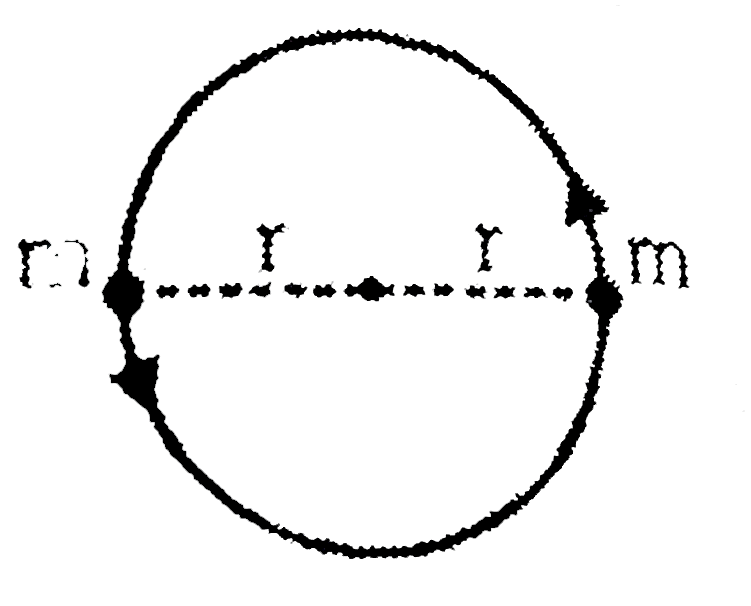Two particles A and B of masses 1 kg and 2 kg respectively are kept 1 m apart and are released to move under mutual attraction. Find The speed A when that of B is 3.6 cm/hr. What is the separation between the particles at this instant?
To solve the problem, we will follow these steps:
Step 1: Understand the system
We have two particles A and B with masses mA=1kg and mB=2kg respectively, initially separated by a distance of r0=1m. They are released to move under their mutual gravitational attraction.
Step 2: Apply conservation of momentum
Since the system is isolated and no external forces are acting on it, the total momentum of the system must be conserved. Initially, both particles are at rest, so the initial momentum is zero.
Let vA be the speed of particle A and vB be the speed of particle B. According to the conservation of momentum:
mAvA+mBvB=0
Substituting the values, we have:
1⋅vA+2⋅(3.6cm/hr)=0
Converting 3.6cm/hr to m/s:
3.6cm/hr=3.6100⋅13600=1⋅10−5m/s
Now substituting:
vA+2⋅(1⋅10−5)=0
vA=−2⋅(1⋅10−5)=−2⋅1⋅10−5m/s=−2⋅10−5m/s
The negative sign indicates that particle A is moving towards particle B.
Step 3: Calculate the speed of A
The speed of A when the speed of B is 3.6cm/hr is:
vA=7.2cm/hr=2⋅3.6cm/hr
Step 4: Apply conservation of energy
Now we need to find the separation between the particles when A is moving at 7.2cm/hr and B at 3.6cm/hr.
The initial potential energy Ui when they are at r0=1m is given by:
Ui=−GmAmBr0=−G⋅1⋅21=−2G
The initial kinetic energy Ki is zero since both are at rest.
The final potential energy Uf when they are at a separation r is:
Uf=−GmAmBr=−G⋅1⋅2r
The final kinetic energy Kf is:
Kf=12mAv2A+12mBv2B
Substituting the speeds in m/s:
Kf=12⋅1⋅(2⋅10−5)2+12⋅2⋅(1⋅10−5)2
Calculating:
Kf=12⋅1⋅4⋅10−10+12⋅2⋅1⋅10−10=2⋅10−10+1⋅10−10=3⋅10−10
Step 5: Set up the conservation of energy equation
Using conservation of energy:
Ui+Ki=Uf+Kf
−2G+0=−2Gr+3⋅10−10
Rearranging gives:
−2Gr=2G+3⋅10−10
Solving for r:
r=2G2G+3⋅10−10
Step 6: Substitute the value of G
Using G=6.67×10−11:
r=2⋅6.67×10−112⋅6.67×10−11+3⋅10−10≈0.3m
Final Answer
The speed of A when the speed of B is 3.6cm/hr is 7.2cm/hr, and the separation between the particles at this instant is 0.3m.
---
We have two particles A and B with masses mA=1kg and mB=2kg respectively, initially separated by a distance of r0=1m. They are released to move under their mutual gravitational attraction.
Since the system is isolated and no external forces are acting on it, the total momentum of the system must be conserved. Initially, both particles are at rest, so the initial momentum is zero.
mAvA+mBvB=0
Substituting the values, we have:
1⋅vA+2⋅(3.6cm/hr)=0
Converting 3.6cm/hr to m/s:
3.6cm/hr=3.6100⋅13600=1⋅10−5m/s
Now substituting:
vA+2⋅(1⋅10−5)=0
vA=−2⋅(1⋅10−5)=−2⋅1⋅10−5m/s=−2⋅10−5m/s
The negative sign indicates that particle A is moving towards particle B.
The speed of A when the speed of B is 3.6cm/hr is:
vA=7.2cm/hr=2⋅3.6cm/hr
Now we need to find the separation between the particles when A is moving at 7.2cm/hr and B at 3.6cm/hr.
Ui=−GmAmBr0=−G⋅1⋅21=−2G
The initial kinetic energy Ki is zero since both are at rest.
Uf=−GmAmBr=−G⋅1⋅2r
The final kinetic energy Kf is:
Kf=12mAv2A+12mBv2B
Substituting the speeds in m/s:
Kf=12⋅1⋅(2⋅10−5)2+12⋅2⋅(1⋅10−5)2
Calculating:
Kf=12⋅1⋅4⋅10−10+12⋅2⋅1⋅10−10=2⋅10−10+1⋅10−10=3⋅10−10
Using conservation of energy:
Ui+Ki=Uf+Kf
−2G+0=−2Gr+3⋅10−10
Rearranging gives:
−2Gr=2G+3⋅10−10
Solving for r:
r=2G2G+3⋅10−10
Using G=6.67×10−11:
r=2⋅6.67×10−112⋅6.67×10−11+3⋅10−10≈0.3m
The speed of A when the speed of B is 3.6cm/hr is 7.2cm/hr, and the separation between the particles at this instant is 0.3m.
Topper's Solved these Questions
- GRAVITATIONBOOK - HC VERMACHAPTER - GRAVITATIONEXERCISE - Short Answer
19 Videos
- GRAVITATIONBOOK - HC VERMACHAPTER - GRAVITATIONEXERCISE - Objective 1
17 Videos
- GRAVITATIONBOOK - HC VERMACHAPTER - GRAVITATIONEXERCISE - Exercises
39 Videos
- FRICTIONBOOK - HC VERMACHAPTER - FRICTIONEXERCISE - Exercises
31 Videos
- HEAT AND TEMPERATUREBOOK - HC VERMACHAPTER - HEAT AND TEMPERATUREEXERCISE - Exercise
4 Videos
Similar Questions
Two particles A and B of masses 1kg and 2kg, respectively, are kept at a very large separation. When they are released, they move under their gravitational attraction. Find the speed (in 10−5m/s) of A when that of B is 3.6cm/hr.
View SolutionTwo particles P and Q of masses 2 kg and 4 kg initially at a distance of 2m from each other are released. If the particles move under mutual attraction, then find speed of particles P when speed of Q is 5 cm/hour. Also find the separation between these particles at this instant.
View Solution
Knowledge Check
Two particles of masses 4kg and 6kgareseparatedbyadistanceof20cm and are moving towards each other under mutual force of attraction, the position of the point where they meet is
A12mfrom 4kg bodyB12m from 6kg bodyC8m from 4kg bodyD10m from 4kg bodyTwo particles of masses 1 kg and 2 kg are placed at a separation of 50 cm find out gravitational force between them
A5.3x10−10NB4.9×10−9NC6.5×10−8ND6.9×x10−7NTwo particles of masses 1kg and 2kg are located at x=0 and x=3m. Find the position of their centre of mass.
A2m from 1 kgB2m from 2 kgC1m from 1 kgDnone of these
Two particles A and B of mass 1 kg and 4 kg respectively approach each other due to their mutual gravitational force only. Then the ratio of acceleration of A to B at any instant is
View SolutionTwo small bodies of masses 10 kg and 20 kg are kept a distnce 1.0 m apart and released. Assuming that only mutual gravitational force are acting, find the speeds of te particles when the separation decreases to 0.5 m.
View SolutionTwo particles each of equal mass (m) move along a circle of radius (r) under the action of their mutual dravitational. Find the speed of each particle.

View SolutionTwo particles of equal mass go round a circle of radius R under the action of their mutual gravitational attraction. Find the speed of each particle.
View Solution10 Two particles of masses m1 and m2 initially at rest start moving towards each other under their mutual force of attraction. The speed of the centre of mass at any time t, when they are at a distance r apart, is
View Solution
